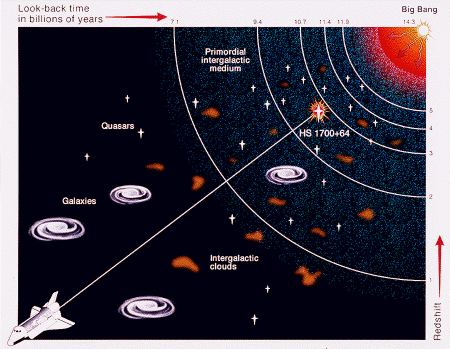|
|||||||||||||||||||
|
|
|||||||||||||||||||
|
|

(Click on the above diagram to see a full resolution version.)
HUT OBSERVATIONS OF THE INTERGALACTIC MEDIUM
The HUT science team's highest priority science goal on Astro-2 was to detect and measure the characteristics of the primordial intergalactic medium (IGM), a hypothesized gas thought to be spread throughout the Universe between the galaxies. This gas should have been created in the Big Bang and then condensed to form the galaxies and stars we see today. The observation required multiple observations of a faint, high redshift quasar, using it as a "background" source to shine through the IGM; absorption of the quasar's light at the "right" ultraviolet wavelengths would indicate the presence of this elusive component of the Universe.
Astronomers have long been interested in observing the IGM directly, as it forms a key link in the chain of events leading from the origin of the Universe to its present-day structure. This project was one of the original motivations for building HUT back when it was proposed to NASA in 1978. An initial attempt to make the required observations was performed during Astro-1, but pointing problems and other operational difficulties caused the program to be abandoned at that time.
Before Astro-2, the IGM apparently was detected for the first time using the Hubble Space Telescope! These observations were very exciting, but were made using quasars of such high redshift that the quasars' light was completely absorbed--the IGM was present, but its characteristics could not be determined. The strength of HUT was that it could observe to shorter wavelengths, and therefore look for signs of the IGM in lower redshift objects where the absorption would not be so strong. This would allow not only the detection of the IGM along a different line of sight, but also permit us to learn about the amount of material involved and what its ionization state was, key clues to this important "missing link" in the evolution of the Universe.
The improved sensitivity of HUT and the stable pointing of the Spacelab IPS on Astro-2, combined with some "luck" provided by Mother Nature, allowed us to make an excellent measurement of the IGM. HUT expended some 12 shuttle pointings (almost 20,000 seconds of observation) on the best quasar candidate for this program, a quasar known as HS 1700+64, which is at a redshift of 2.74. The HUT data show an absorption at just the expected range of wavelengths to be due to the expected effects of the IGM. Furthermore, the spectrum does not drop to zero, as do the Hubble QSO spectra, but hovers in an intermediate range that allows the properties of the IGM to be investigated. Analysis of the HUT spectrum shows that the quasars at high redshift are the likely source of the ionization of material in the IGM, and that there is roughly 4-6 times more mass of "normal" (called "baryonic") material in the IGM than there is in all of the known stars and galaxies combined! While this is not nearly enough material to "close" the Universe or account for the so-called "missing mass" in clusters of galaxies and elsewhere, it does say that only something like 20% of the material created in the Big Bang actually coalesced into the "structure" (galaxies and stars) that we see in the Universe today. The rest of it is "out there" between the galaxies in the form of the exceedingly tenuous intergalactic medium. Now there's a "far out" result!
The technical report of this work can be found in an article by A. F. Davidsen, G. A. Kriss, and W. Zheng in the journal Nature, vol. 380, p. 47 (1996).
|
|
|




 Follow Us
Follow Us